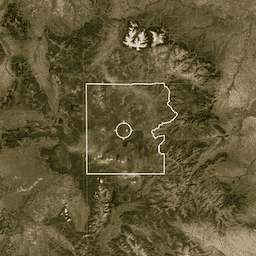
- 数据集可用性
- 2018-09-01T00:00:00Z–2018-09-01T00:00:00Z
- 数据集提供商
- 美国地质调查局
- 标签
说明
PAD-US 是美国官方的国家级陆地和海洋保护区清单,这些保护区致力于保护生物多样性以及其他自然、休闲和文化用途,并通过法律或其他有效手段进行管理,以实现这些目的。此数据库分为 4 个单独的表资产:指定、地役权、费用和公告。
“公告”资产包含边界,可为“费用”“指定”或“地役权”资产中的地块提供额外的背景信息,适合以轮廓形式显示,因为其中不包含内部所有权信息。这些边界包括军事用地、公告边界(国家公园管理局和林务局)或已获批准的收购边界(美国鱼类及野生动物管理局)。
PAD-US 数据库力求全面收录专门用于保护生物多样性的区域,以及通过法律或其他有效手段进行管理以实现这些目的的其他自然(包括提取)、休闲或文化用途的区域。PAD-US 是由各个机构和组织在特定时间点提供的“最佳可用”空间数据的汇总。这包括土地的产权以及通过租赁、地役权或其他具有约束力的协议进行的土地管理。这些数据还跟踪了管理计划中确定的国会指定、行政指定和行政管理指定(例如土地管理局的“环境关注区”)。这些因素共同构成了一个强大的数据集,可提供美国复杂的保护区网络的空间表示。在考虑如何处理数据时,请务必先确定具体的分析问题。作为从权威来源数据汇总的完整区域清单,PAD-US 包含重叠的指定类型以及机构数据集之间的小边界差异。重叠指定主要发生在“指定”或“组合”要素类的联邦地产中(例如“荒野地区”位于“野河和美河”和“国家森林”之上)。
请务必注意是否存在重叠,尤其是在尝试计算面积统计信息时;重叠的边界会多次计算同一地面区域。虽然仍存在一些细微的边界差异,但“费用”资产中已移除大部分主要重叠部分,因此这是根据土地管理者(“管理者名称”)在 PAD-US 数据库中计算总陆地面积的最佳来源(数据缺口会限制按费用所有权或“所有者名称”进行的计算)。通过分析 PAD-US 1.4“组合”要素类,可获得按管理机构或组织汇总的“公共访问”或保护状态(“GAP 状态代码”)统计信息,这些信息可供使用,并且会随 PAD-US 2.0 进行更新。由于 PAD-US 数据库是源数据的直接汇总,因此 PAD-US 开发团队不会更改空间线状要素。例外情况是,沿州边界线“剪裁”土地数据(使用美国人口普查局提供的权威州边界文件),并移除此流程创建的与州或地方土地(而非联邦或非营利土地)相关的小段边界。数据集中仍存在一些边界差异(或细微的重叠)。我们已发现并分享了数据重叠情况,同时还向机构数据管家分享了美国人口普查局州管辖区边界文件,以便他们修改源文件,这些修改随后会纳入后续的 PAD-US 版本。PAD-US 数据库是与许多合作伙伴和数据管理员协作构建的。 可提供有关数据管家的信息。
表架构
表架构
| 名称 | 类型 | 说明 |
|---|---|---|
| Agg_Src | STRING | 数据汇总方的来源。 |
| 类别 | STRING | 保护类型:指定、地役权、费用、海洋、其他、公告或未知。 |
| 评论 | STRING | 其他意见。 |
| Date_Est | STRING | 保护区建立年份。 |
| Des_Tp | STRING | 指定类型的详细信息,例如“严重的环境问题区域”“当地公园”“国家公园”“荒野区域”等。 |
| EsmtHldr | STRING | 持有地役权的组织。 |
| EHoldTyp | STRING | 地役权持有人的类型。 |
| FeatClass | 双精度 | 唯一的 ID。 |
| GAP_Sts | STRING | 保护级别或“状态”:
|
| GAPCdDt | STRING | 确定状态代码的日期。 |
| GAPCdSrc | STRING | 状态代码的来源。 |
| GIS_Acres | 双精度 | 计算出的保护区面积(以英亩为单位)。 |
| GIS_Src | STRING | GIS 数据的来源。 |
| Src_Date | STRING | GIS 数据所代表的日期。 |
| IUCN_Cat | STRING | 使用 IUCN 保护状态的保护级别:
|
| IUCNCtDt | STRING | IUCN 类别的日期。 |
| IUCNCtSrc | STRING | IUCN 保护状态的来源。 |
| Loc_Ds | STRING | 地方一级的保护区指定。 |
| Loc_Mang | STRING | 保护区的管理者。 |
| Loc_Nm | STRING | 保护区的名称。 |
| Loc_Own | STRING | 保护区的所有者。 |
| Mang_Name | STRING | 管理组织的名称。 |
| Mang_Type | STRING | 经理账号类型。 |
| Own_Name | STRING | 受保护区域所有者的姓名。 |
| Own_Type | STRING | 所有者组织的类型。 |
| 访问 | STRING | 受保护区域的可达性。 |
| Access_Dt | STRING | 访问日期。 |
| Access_Src | STRING | 访问数据的来源。 |
| ID | STRING | 受保护区域的 ID。 |
| State_Nm | STRING | 双字母缩写的州名 |
| Unit_Nm | STRING | 单位名称 |
| WDPA_Cd | STRING | 与 WDPA 数据集关联的网站代码。 |
使用条款
使用条款
PAD-US 2.0 的数字对象标识符 doi:10.5066/P955KPLE 提供了一个持久性引用,应使用该引用来获取数据以供使用。美国地质调查局和所有提供数据的合作伙伴均不对本文所述和(或)所含数据的错误或不当使用承担任何责任。所有信息都是根据特定的最终用途或使用场景创建的。对于地理信息系统 (GIS) 数据来说,这一点尤其重要,因为此类数据的制作成本很高,必须定向投放才能满足当前的计划需求。创建这些数据时,我们希望它们能用于其他应用;不过,以下列出了不当用途。此列表并非详尽无遗,但可作为指南,帮助您评估所提议的用途是否可由这些数据提供支持。在许多用途中,PAD-US 不太可能提供所需的唯一数据;对于具有监管结果的用途,权威机构数据和实地调查应验证结果。建议需要了解多个机构或组织土地基本信息的用户使用 PAD-US。用户应直接从权威来源获取数据,以解答有关某个机构的问题或需要更频繁更新的问题。最终,每个数据用户都有责任确定这些数据是否可以回答所提出的问题。不当使用包括:将 PAD-US 用于与某个机构或特定单位相关的应用或分析(机构始终是其土地数据的最佳权威来源,许多机构的更新频率比 PAD-US 更高)。使用一些数据来绘制小区域(不到数千公顷)的地图,通常需要 1:24,000 比例的地图分辨率(边界质量因数据源而异),并在数据不完整的区域使用航空照片或地面测量。将这些数据与其他比例尺小于 1:100,000 的数据相结合,以生成新的混合地图或回答查询。根据数据生成比最接近的千公顷更精细的特定面积测量结果。以法律表示形式表示边界,用于监管或收购。确定某个确切地理区域内任何特征的明确出现或不出现。确定任何特征的丰度、健康状况或条件。使用数据,但未获取和查看元数据。
引用
美国地质调查局 (USGS) 缺口分析项目 (GAP),2018 年,《美国保护区数据库》(PAD-US):美国地质调查局数据发布,doi:10.5066/P955KPLE。
DOI
使用 Earth Engine 探索
代码编辑器 (JavaScript)
var dataset = ee.FeatureCollection('USGS/GAP/PAD-US/v20/proclamation'); // Encode 'GAP_Sts' (protection level) as a number for visualization. dataset = dataset.map(function(feature) { return feature.set('status', ee.Number.parse(feature.get('GAP_Sts'))); }); // Paint new 'status' value to an image for visualization. var datasetVis = ee.Image().byte().paint(dataset, 'status'); var visualization = { min: 1, max: 4, palette: ['b1a44e', '4eb173', '4e5bb1', 'b14e8c'] }; Map.setCenter(-92.852, 31.549, 8); Map.addLayer(datasetVis, visualization, 'Protection status'); Map.addLayer(dataset, null, 'FeatureCollection', false);
以 FeatureView 形式直观呈现
FeatureView 是 FeatureCollection 的只读加速表示形式。如需了解详情,请访问
FeatureView 文档。
代码编辑器 (JavaScript)
var fvLayer = ui.Map.FeatureViewLayer( 'USGS/GAP/PAD-US/v20/proclamation_FeatureView'); var visParams = { opacity: 1, color: { property: 'GAP_Sts', categories: [ ['1', 'b1a44e'], ['2', '4eb173'], ['3', '4e5bb1'], ['4', 'b14e8c'] ] } }; fvLayer.setVisParams(visParams); fvLayer.setName('Protection status'); Map.setCenter(-92.852, 31.549, 8); Map.add(fvLayer);
